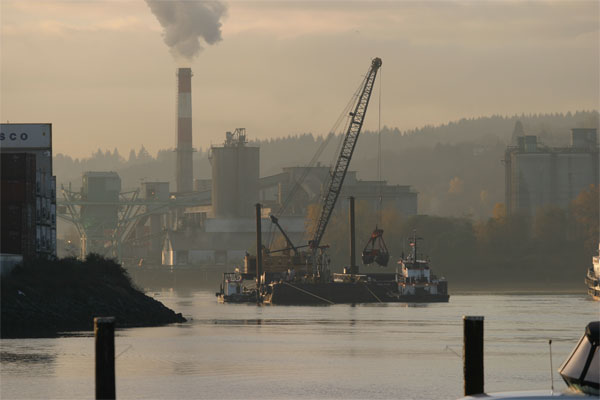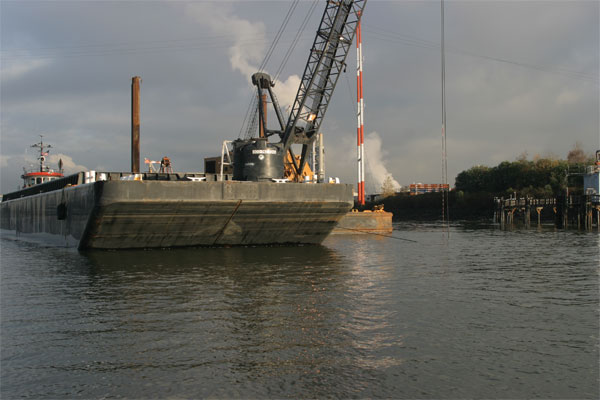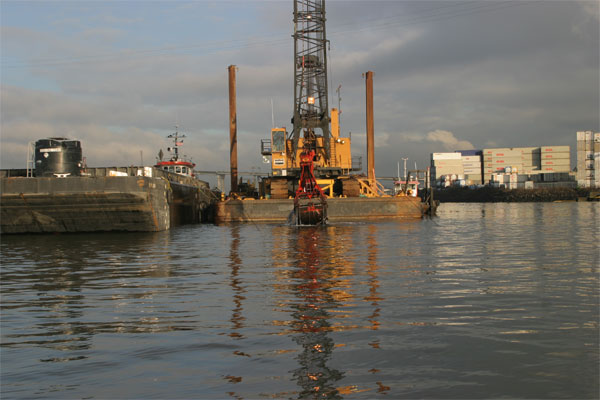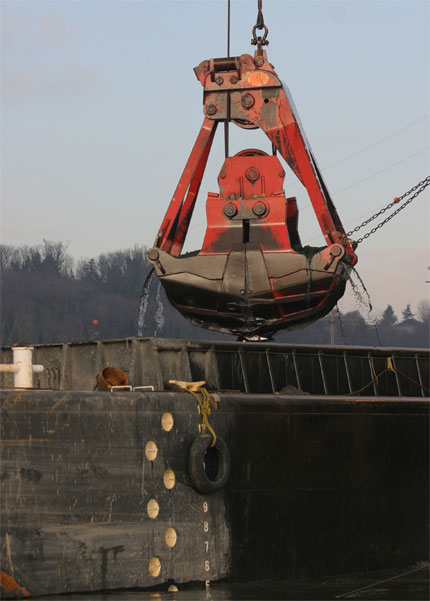Duwamish/Diagonal Sediment Remediation Project
Information about King County’s project in the Duwamish/Diagonal area to address historical sediment contamination near County combined sewer overflow (CSO) outfalls.
Project description
The initial study for this project, issued in January 2002, proposed a cleanup area of about 5 acres. In February 2002 during public review of the study, comments were received that recommended expanding the site to include an adjacent 2 acre area upstream. After further evaluation, the EBDRP Panel expanded the project.
The Duwamish/Diagonal is located on the east side of the Duwamish River, upstream of Harbor Island and immediately downstream of Kellogg Island in the lower portion of the Duwamish River.
The original cleanup area extended about 750 feet along the shoreline upstream and downstream of the Duwamish/Diagonal Way outfalls. It was 260 feet wide. The project expansion extended the site about 500 feet along the shoreline upstream and downstream of the former Diagonal Avenue Treatment Plant outfall and the Diagonal Avenue South storm drain outfall. It was 160 feet wide and did not extend to the shoreline.
The project isolated contaminated sediment near four outfall pipes on the Duwamish River in Seattle:
- Diagonal Way storm drain
- Duwamish combined sewer overflow
- the former Diagonal Avenue Treatment Plant outfall
- Diagonal Avenue South storm drain.
These areas were dredged to an average depth of 5 feet and 66,000 cubic yards of contaminated material was removed. The dredged material contained polychlorinated biphenyls, or PCBs, but all dredged sediment was below the Toxic Substances Control Act (TSCA) PCB limit. The contaminated sediment handled by Rabanco waste disposal and shipped by train to the Roosevelt Landfill in Klickitat County.
The project isolated any remaining contaminated sediment from the environment by building an isolating sediment cap. The cap surface was also designed to provide beneficial salmon foraging habitat.
A follow up action was conducted in February 2005. A thin layer of sand was placed around a portion of the dredged area to reduce the level of contaminants from the previous dredging activity.
The Duwamish/Diagonal area is identified under the County's 1999 Sediment Management Plan as needing cleanup. The plan evaluated remediation strategies for correcting hazards caused by contaminated sediments near seven King County CSOs.
This project was part of the Elliott Bay/Duwamish Restoration Program, or EBDRP. EBDRP is the result of a 1991 legal settlement reached by the City of Seattle and King County (then the Municipality of Metropolitan Seattle, or Metro) with the National Oceanic and Atmospheric Administration, or NOAA.
The EBDRP settlement projects included sediment remediation, habitat development and improvements, and pollution source-control measures. The U.S. Fish and Wildlife Service, Washington State Department of Ecology (Ecology), Suquamish Tribe, Muckleshoot Tribe, NOAA, City of Seattle and King County administer the program and make up the EBDRP Panel.
The U.S. Environmental Protection Agency, Ecology, King County and City of Seattle worked together on source control, project planning and design for the Duwamish/Diagonal Sediment Remediation Project.
The areas around the Duwamish/Diagonal Sediment Remediation Project are being evaluated to determine what additional sediment remediation is necessary as part of the Lower Duwamish Waterway Superfund project.
Vicinity map
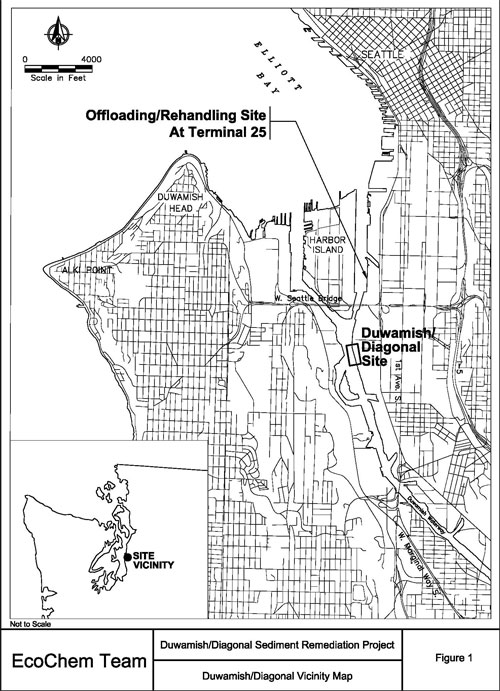
Duwamish/Diagonal Vicinity Map
The Duwamish/Diagonal Cleanup Area is located approximately 3 kilometers from the mouth of the Duwamish Waterway at Elliot Bay, within the south industrial section of Seattle, Washington. The Duwamish/Diagonal outfalls are located on the east side of the Duwamish Waterway, upstream of Harbor Island and immediately downstream of Kellogg Island.
Project library
Department of Ecology Reports
- Final Sediment Management Standards Cleanup Action Decision: Duwamish Diagnonal CSO/SD: July 2002 (1.1MB)
- Sediment Management Standards Cleanup Action Decision Amendment: December 2004 (1.6MB)
Cleanup Study Reports
- Expanded Area for the Duwamish Diagonal Cleanup Project Addendum: April 2002 (6.7MB)
- Response to Reviewers Comments on the Draft Cleanup Study Report for the Duwamish Diagonal CSO/SD: April 2002 (3.8MB)
- Source Control Summary for the Duwamish Diagonal Cleanup Project Addendum April 2002 (2.7MB)
- Duwamish/Diagonal CSO/SD Cleanup Study Report, Elliott Bay/Duwamish Restoration Program, October 2005
- Part I (3.8MB)
- Part II (6.9MB)
- Appendices A-C (4.6MB)
- Appendices D-H (10.6 MB)
- Appendices I-N (9.9MB)
- Appendices O-T (6.4MB)
Closure Reports
- Duwamish/Diagonal CSO/SD Sediment Remediation Project: Closure Report July 2005 (4.6MB)
- Duwamish/Diagonal Sediment Remediation Project 4-Acre Residuals Interim Action Closure Report May 2007 (10.3MB)
Monitoring Reports
- Duwamish/Diagonal Sediment Remediation Project: 2011 and 2012 Monitoring Report, April 2016
- Report only - no appendices (5.1MB)
- Report Appendices (6.5 MB)
- Duwamish/Diagonal Sediment Remediation Project: Final 2010 Monitoring Report, May 2015
- Report only - no appendices (13.9MB)
- All appendices except Appendix C (4.8 MB)
- Appendix C - 2010 Complete Sediment Chemistry Analytical Results in Dry Weight (2.6 MB)
- Duwamish/Diagonal Sediment Remediation Project: 2008/2009 Monitoring Report, May 2010
- Report only - no appendices (330KB)
- Report with appendices, except Appendix B (2MB)
- Appendix B, QA1 Quality Assurance Review Narratives (27MB)
- Duwamish/Diagonal Sediment Remediation Project: 2006/2007 Monitoring Report, December 2008
- Report, including Appendix B and C
- Appendix A - QA1 Quality Assurance Review Package
- A1 - Sediment Cap 2006 (9.4MB)
- A2 - Sediment Cap 2007 (16.7MB)
- A3 - ENR 2006 (11.5MB)
- A4 - ENR 2007 (13.4MB)
- A5 - Perimeter Station 2006 (12.3MB)
- A6 - Perimeter Station 2007 (12.2MB)
- Duwamish/Diagonal Sediment Remediation Project: 2005 Monitoring Report May 2007 (5.4MB)
- Duwamish/Diagonal Sediment Remediation Dredging and Capping Operations: Sediment Monitoring, Sampling and Analysis Plan October 2003 (1.6MB)

 Translate
Translate
